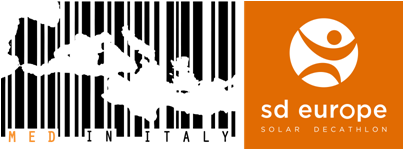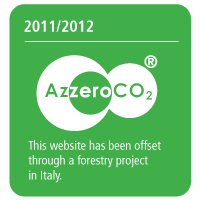
MED IN ITALY AL SOLAR DECATHLON 2012:
PER LA PRIMA VOLTA UNA CASA MEDITERRANEA ALLE OLIMPIADI DELL’ARCHITETTURA GREEN
Presentato durante la Giornata Nazionale Giornalisti nell’Erba il progetto italiano per Madrid 2012
Roma, 27 maggio 2011. Una casa che produce più energia di quanta ne consuma, che può essere realizzata in due giorni e montata in otto, che è in grado di rispondere persino all’emergenza di un post terremoto o ai drammatici problemi di un’ondata di migranti in fuga da un conflitto. Una casa adatta soprattutto al caldo, pensata e realizzata per resistere al cambiamento climatico, perfetta per una struttura di turismo sostenibile. Una casa progettata in modo che le pareti potranno essere realizzate con materiali locali, per adattarsi a tutti i paesaggi. Infine, una casa che consuma un quarto dell’energia usata nelle abitazioni tradizionali.
È MED in Italy, il progetto che un team composto da docenti e studenti dell’Università di Roma TRE in partenariato con il Laboratorio di disegno industriale della Sapienza porterà a Solar Decathlon, la gara internazionale ideata dal Dipartimento Energia degli Stati Uniti, una vera e propria Olimpiade dell’architettura green.È stato presentato oggi a Frascati presso ESA, durante la Giornata Nazionale Giornalisti nell’Erba, assieme al plastico dell’abitazione che verrà progettata nei minimi particolari e spedita a Madrid dopo più di un anno di ulteriore lavoro. Nella capitale spagnola, nel settembre 2012, MED in Italy parteciperà a una vera e propria gara tra prototipi abitativi assieme ad altre 19 case provenienti da 14 paesi: Brasile, Cina, Danimarca, Egitto, Francia, Germania, Gran Bretagna, Giappone, Norvegia, Paesi Bassi, Portogallo, Romania, Spagna e Ungheria.
È la prima volta in quasi 10 anni, a partire dalla prima edizione di Solar decathlon nel 2002, che un team italiano viene ammesso alla competizione mondiale dell’architettura sostenibile. Per vincere la palma di edificio più verde dell’anno dovrà superare dieci prove (decathlon, appunto, come nelle vere Olimpiadi): la sfida si snoda lungo i percorsi dell’architettura, della capacità costruttiva, dell’efficienza, del bilancio energetico, del comfort, della funzionalità, della comunicazione, della produzione e fattibilità economica, dell’innovazione, della sostenibilità. Per ognuna delle ‘gare’ i prototipi riceveranno un punteggio da una giuria internazionale (fino a un massimo che, a seconda dei settori, arriverà a 80 o 120 punti). Med in Italy reinterpreta, in versione contemporanea, la tradizione mediterranea, attraverso un patio esterno ombreggiato in cui si coltivano ortaggi mediterranei, le grandi murature del passato in grado di accumulare il calore, lo spazio interno organizzato per favorire lo stile di vita mediterraneo, la produzione di energia elettrica da fotovoltaico organico, derivato cioè dal succo di arancia.
“In realtà, la vera vittoria è già nell’essere stati scelti fra le centinaia di progetti presentati: quest’ammissione dà diritto a un premio che ha permesso l'avvio del progetto per il prototipo”, spiega la Team leader di MED in Italy, l’architetto Chiara Tonelli. “Med in Italy – aggiunge - viene progettata con maggiore attenzione all’isolamento dal caldo piuttosto che a quello dal freddo. L’architettura verde ha avuto negli ultimi decenni caratteristiche più nordiche che meridionali, ma noi mediterranei abbiamo una tradizione antichissima, che abbiamo recuperato e reinterpretato nella progettazione. Così la nostra casa resterà isolata dall’esterno nelle ore più calde e si aprirà quando il sole cala, mentre uno spazio aperto a patio funzionerà da zona di raffrescamento. L’amplissimo bagaglio di conoscenze tradizionali della regione mediterranea verrà declinato in un’architettura contemporanea e bella a vedersi. Inoltre sarà coniugato a tutte le tecnologie a basso consumo energetico e all’utilizzo del solare fotovoltaico: MED in Italy produrrà più energia di quanta ne consumi”.
Ogni anno MED in Italy produrrà 3.900 kilowattora con la tecnologia fotovoltaica organica, ma consumerà solo la metà di questa energia: così la casa immetterà in rete circa 1.800 kilowattora. La tecnologia fotovoltaica organica è stata scelta per il minor contenuto di energia primaria inglobato dal modulo: infatti può essere prodotta vicino ai luoghi di costruzione dell’abitazione, diminuendo i consumi di energia legati ai trasporti, permette una completa riciclabilità dei componenti ed utilizza materiali di facile reperibilità ed ecocompatibili. Meno CO2, più comfort e più risparmio: l’efficienza dei sistemi permetterà alla casa di funzionare perfettamente, con elettrodomestici, illuminazione, acqua calda e temperature adeguate, eliminando la bolletta elettrica.
Un risultato straordinario a cui si è arrivati attraverso una valutazione che tiene conto dei rendimenti energetici di tutti gli elettrodomestici presenti: ogni angolo della casa viene progettato pensando a quanto riuscirà a incidere sul risparmio energetico globale dell’abitazione. Lavatrici che garantiscono il bianco più bianco senza superare i 43 gradi e mezzo, lavastoviglie che non vanno oltre i 49 gradi: l’impegno sarà altissimo anche dal punto di vista della progettazione della filiera industriale italiana e il team sta raccogliendo le sponsorizzazioni e le collaborazioni necessarie alla messa a punto di ogni dettaglio.
Ma non sono solo le performance energetiche ed ambientali a costituire gli asset con cui il team italiano si presenterà al Solar Decathlon Europe (la competizione si svolge ad anni alternati negli Stati Uniti e in Europa, e dal 2013 anche in Cina). Nelle strettissime regole di gara, ad avere peso rilevante sono la piacevolezza delle linee architettoniche, la facilità di costruzione e la replicabilità, ma anche la gradevolezza dell’abitare: tra le prove, ad esempio, sono previste tre cene che i team partecipanti dovranno preparare e offrire agli altri concorrenti, da cui saranno giudicati. Così, anche la capacità di comunicazione sarà valutata nelle prove.
Il progetto della casa mediterranea ha ricevuto l'Alto Patronato della Presidenza della Repubblica, il patrocinio della provincia di Roma e un patrocinio oneroso del Ministero per le Politiche Agricole, Alimentari e Forestali. Partner istituzionale, l'Agenzia Casaclima. Sponsor tecnico: Rubner Haus AG.
Per informazioni:
Silverback - Greening the Communication
Paola Richard - p.richard@silverback.it – mobile 366 1645501
Giovanni Nani – mobile 335 474212
















